ICT700 Systems Analysis Report: Agile Methods for OZES Company
VerifiedAdded on 2023/01/18
|12
|2361
|67
Report
AI Summary
This report provides a comprehensive system analysis focusing on the application of agile methods for the Australian Electric Supply (OZES) company. It begins with an executive summary outlining the report's structure and objectives, which include evaluating Extreme Programming, Dynamic System Development Model (DSDM), Crystal Method, and Lean Development. The report then delves into each method, discussing their advantages and disadvantages within the context of the OZES case study. The second part of the report demonstrates the information system through an event table, use case diagram, model class diagram, and specific class diagrams for the "Order" and "Associate Broker" classes. The conclusion suggests a combination of Lean Development and the Crystal Method as the most suitable approach for OZES. The report also includes a memo discussing User-Centered Design (UCD) and Human-Computer Interaction (HCI) principles to enhance software usability and customer interaction, along with references and an appendix.
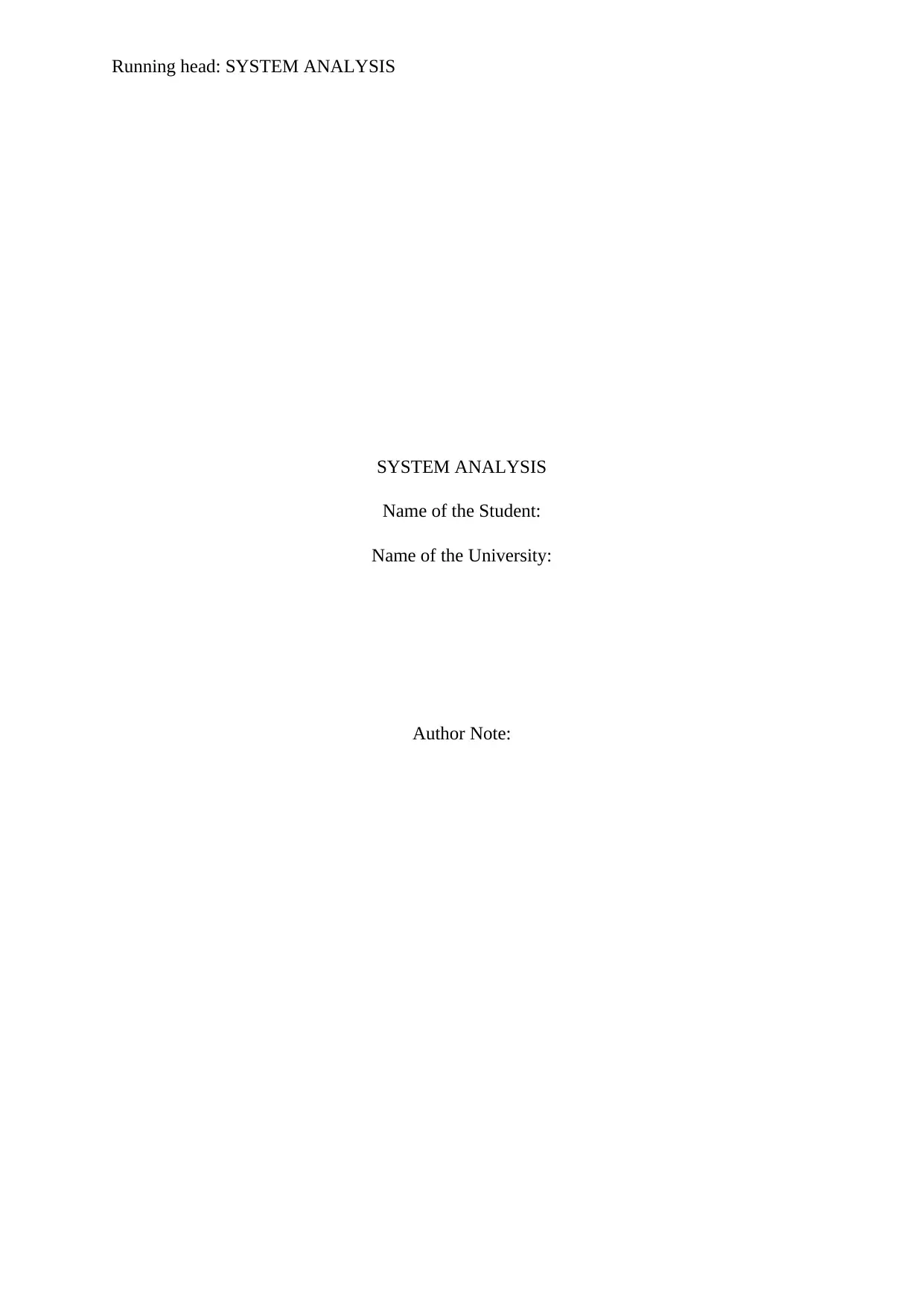
Running head: SYSTEM ANALYSIS
SYSTEM ANALYSIS
Name of the Student:
Name of the University:
Author Note:
SYSTEM ANALYSIS
Name of the Student:
Name of the University:
Author Note:
Paraphrase This Document
Need a fresh take? Get an instant paraphrase of this document with our AI Paraphraser
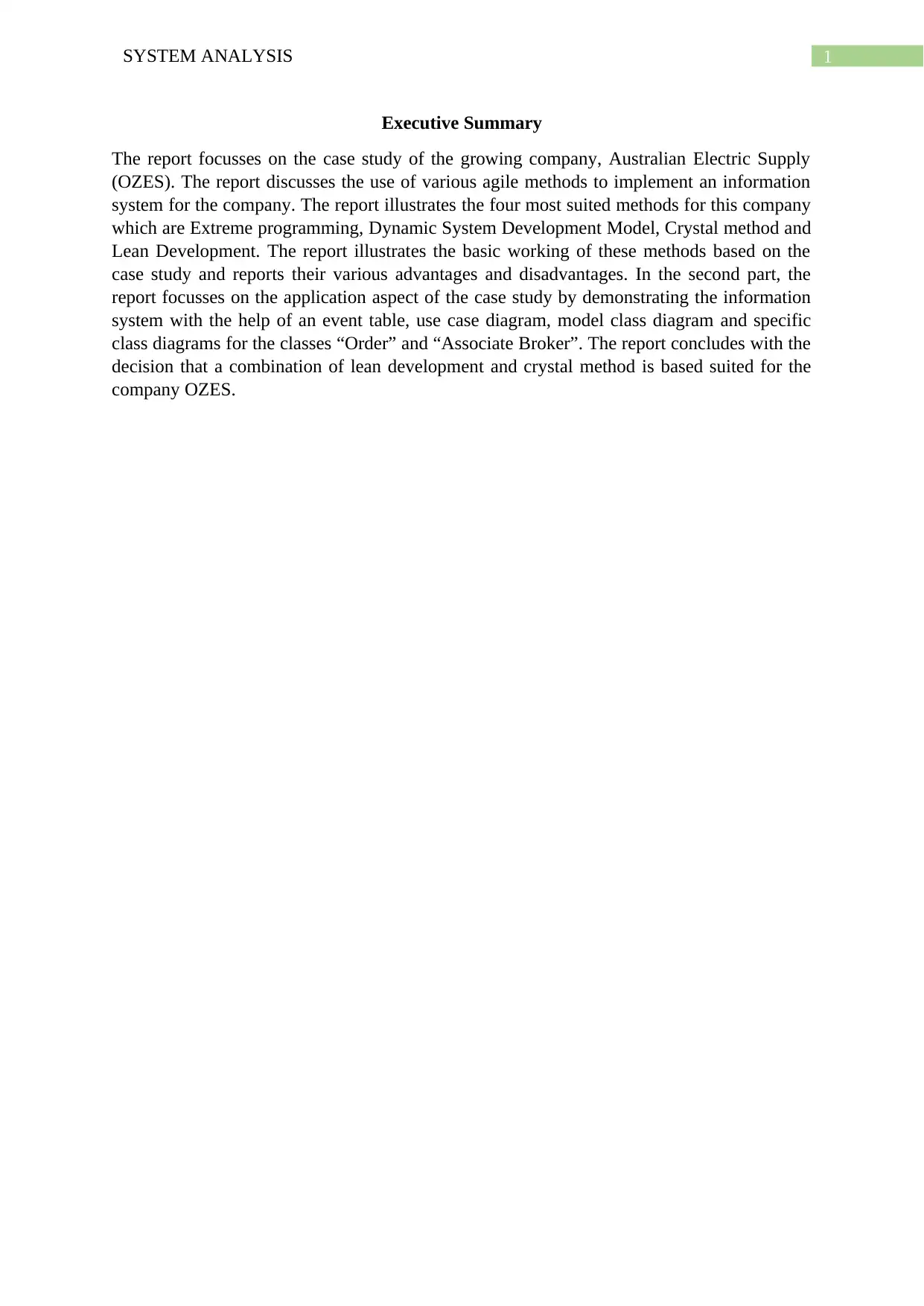
1SYSTEM ANALYSIS
Executive Summary
The report focusses on the case study of the growing company, Australian Electric Supply
(OZES). The report discusses the use of various agile methods to implement an information
system for the company. The report illustrates the four most suited methods for this company
which are Extreme programming, Dynamic System Development Model, Crystal method and
Lean Development. The report illustrates the basic working of these methods based on the
case study and reports their various advantages and disadvantages. In the second part, the
report focusses on the application aspect of the case study by demonstrating the information
system with the help of an event table, use case diagram, model class diagram and specific
class diagrams for the classes “Order” and “Associate Broker”. The report concludes with the
decision that a combination of lean development and crystal method is based suited for the
company OZES.
Executive Summary
The report focusses on the case study of the growing company, Australian Electric Supply
(OZES). The report discusses the use of various agile methods to implement an information
system for the company. The report illustrates the four most suited methods for this company
which are Extreme programming, Dynamic System Development Model, Crystal method and
Lean Development. The report illustrates the basic working of these methods based on the
case study and reports their various advantages and disadvantages. In the second part, the
report focusses on the application aspect of the case study by demonstrating the information
system with the help of an event table, use case diagram, model class diagram and specific
class diagrams for the classes “Order” and “Associate Broker”. The report concludes with the
decision that a combination of lean development and crystal method is based suited for the
company OZES.
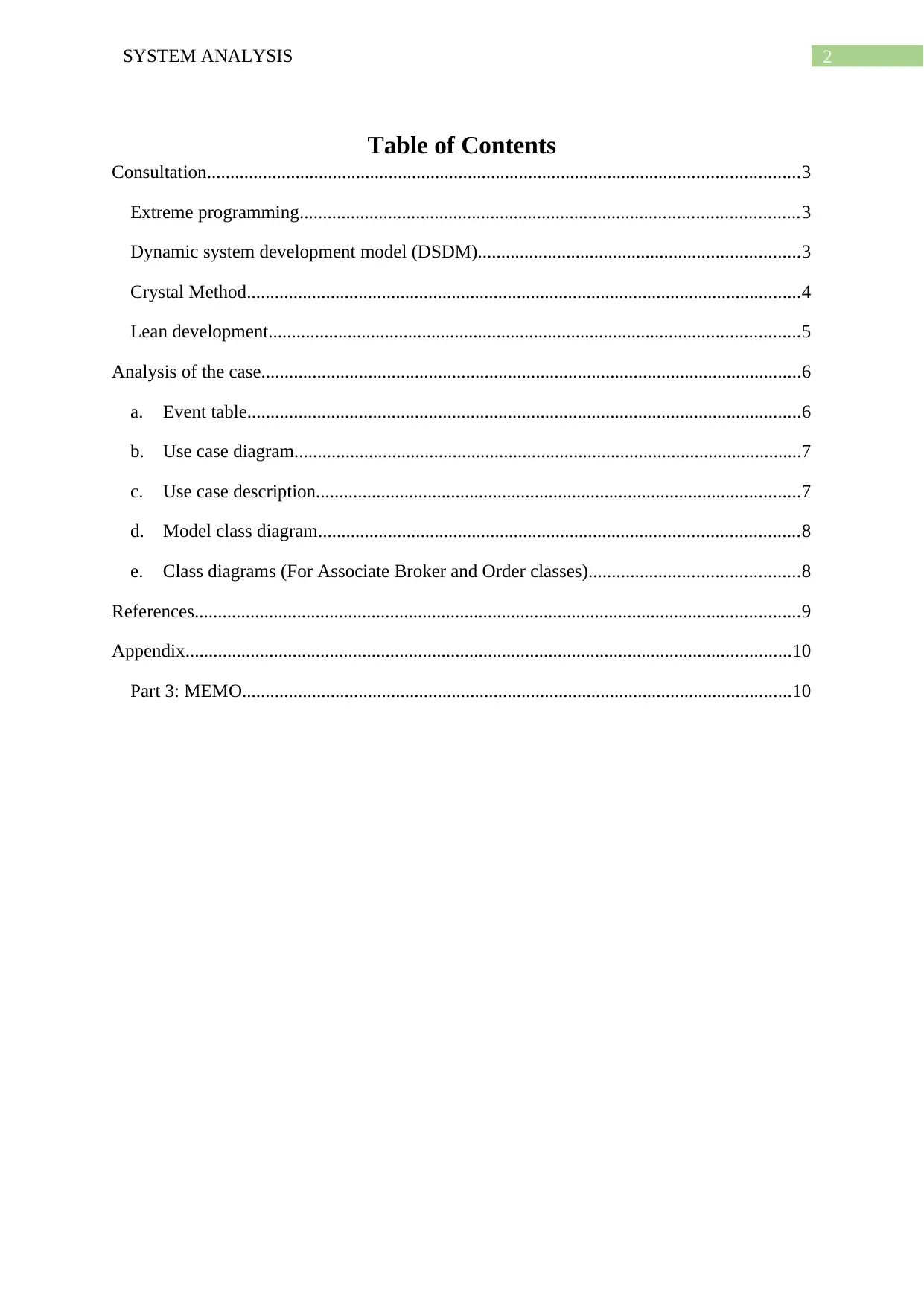
2SYSTEM ANALYSIS
Table of Contents
Consultation...............................................................................................................................3
Extreme programming...........................................................................................................3
Dynamic system development model (DSDM).....................................................................3
Crystal Method.......................................................................................................................4
Lean development..................................................................................................................5
Analysis of the case....................................................................................................................6
a. Event table.......................................................................................................................6
b. Use case diagram.............................................................................................................7
c. Use case description........................................................................................................7
d. Model class diagram.......................................................................................................8
e. Class diagrams (For Associate Broker and Order classes).............................................8
References..................................................................................................................................9
Appendix..................................................................................................................................10
Part 3: MEMO......................................................................................................................10
Table of Contents
Consultation...............................................................................................................................3
Extreme programming...........................................................................................................3
Dynamic system development model (DSDM).....................................................................3
Crystal Method.......................................................................................................................4
Lean development..................................................................................................................5
Analysis of the case....................................................................................................................6
a. Event table.......................................................................................................................6
b. Use case diagram.............................................................................................................7
c. Use case description........................................................................................................7
d. Model class diagram.......................................................................................................8
e. Class diagrams (For Associate Broker and Order classes).............................................8
References..................................................................................................................................9
Appendix..................................................................................................................................10
Part 3: MEMO......................................................................................................................10
⊘ This is a preview!⊘
Do you want full access?
Subscribe today to unlock all pages.

Trusted by 1+ million students worldwide
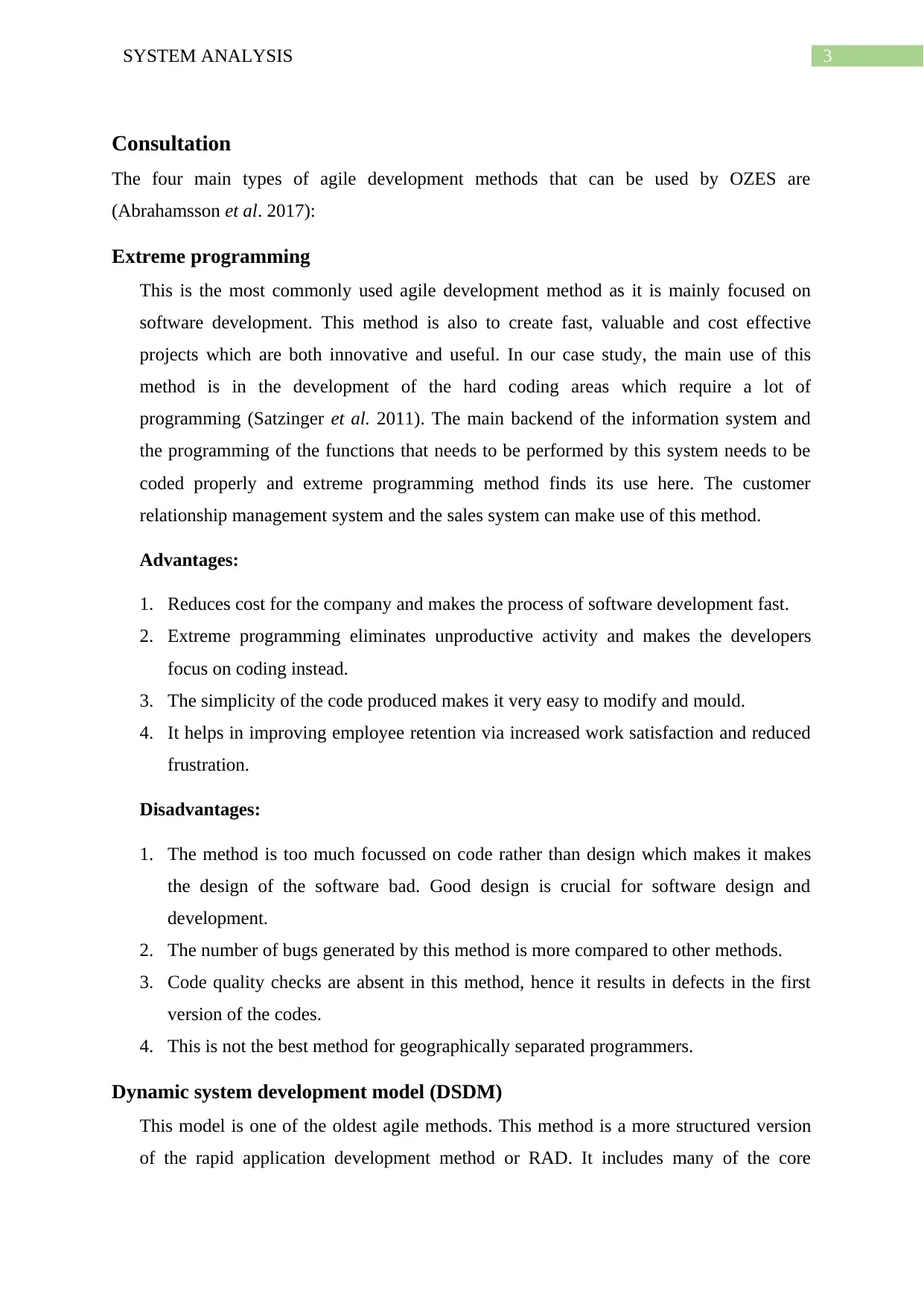
3SYSTEM ANALYSIS
Consultation
The four main types of agile development methods that can be used by OZES are
(Abrahamsson et al. 2017):
Extreme programming
This is the most commonly used agile development method as it is mainly focused on
software development. This method is also to create fast, valuable and cost effective
projects which are both innovative and useful. In our case study, the main use of this
method is in the development of the hard coding areas which require a lot of
programming (Satzinger et al. 2011). The main backend of the information system and
the programming of the functions that needs to be performed by this system needs to be
coded properly and extreme programming method finds its use here. The customer
relationship management system and the sales system can make use of this method.
Advantages:
1. Reduces cost for the company and makes the process of software development fast.
2. Extreme programming eliminates unproductive activity and makes the developers
focus on coding instead.
3. The simplicity of the code produced makes it very easy to modify and mould.
4. It helps in improving employee retention via increased work satisfaction and reduced
frustration.
Disadvantages:
1. The method is too much focussed on code rather than design which makes it makes
the design of the software bad. Good design is crucial for software design and
development.
2. The number of bugs generated by this method is more compared to other methods.
3. Code quality checks are absent in this method, hence it results in defects in the first
version of the codes.
4. This is not the best method for geographically separated programmers.
Dynamic system development model (DSDM)
This model is one of the oldest agile methods. This method is a more structured version
of the rapid application development method or RAD. It includes many of the core
Consultation
The four main types of agile development methods that can be used by OZES are
(Abrahamsson et al. 2017):
Extreme programming
This is the most commonly used agile development method as it is mainly focused on
software development. This method is also to create fast, valuable and cost effective
projects which are both innovative and useful. In our case study, the main use of this
method is in the development of the hard coding areas which require a lot of
programming (Satzinger et al. 2011). The main backend of the information system and
the programming of the functions that needs to be performed by this system needs to be
coded properly and extreme programming method finds its use here. The customer
relationship management system and the sales system can make use of this method.
Advantages:
1. Reduces cost for the company and makes the process of software development fast.
2. Extreme programming eliminates unproductive activity and makes the developers
focus on coding instead.
3. The simplicity of the code produced makes it very easy to modify and mould.
4. It helps in improving employee retention via increased work satisfaction and reduced
frustration.
Disadvantages:
1. The method is too much focussed on code rather than design which makes it makes
the design of the software bad. Good design is crucial for software design and
development.
2. The number of bugs generated by this method is more compared to other methods.
3. Code quality checks are absent in this method, hence it results in defects in the first
version of the codes.
4. This is not the best method for geographically separated programmers.
Dynamic system development model (DSDM)
This model is one of the oldest agile methods. This method is a more structured version
of the rapid application development method or RAD. It includes many of the core
Paraphrase This Document
Need a fresh take? Get an instant paraphrase of this document with our AI Paraphraser
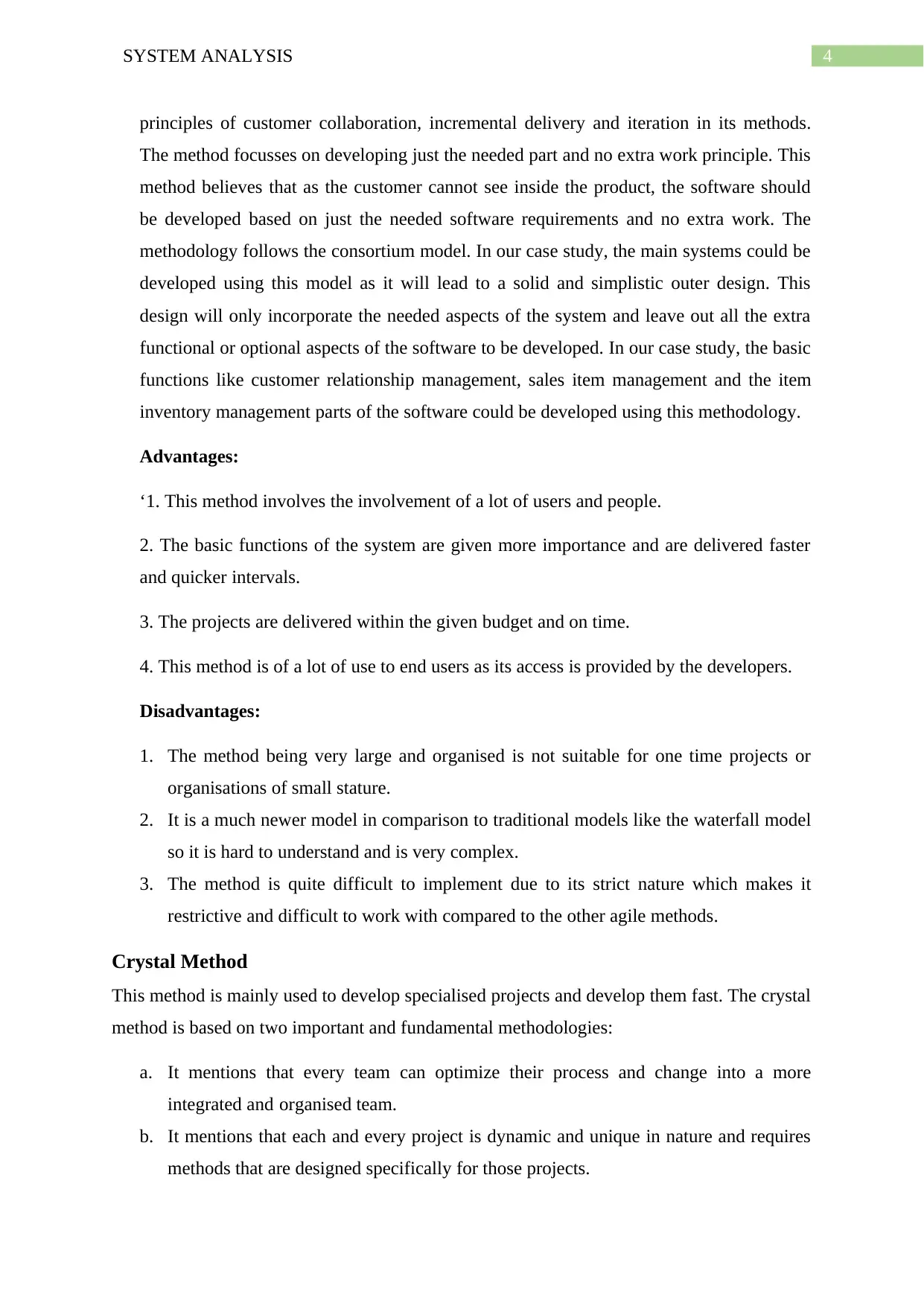
4SYSTEM ANALYSIS
principles of customer collaboration, incremental delivery and iteration in its methods.
The method focusses on developing just the needed part and no extra work principle. This
method believes that as the customer cannot see inside the product, the software should
be developed based on just the needed software requirements and no extra work. The
methodology follows the consortium model. In our case study, the main systems could be
developed using this model as it will lead to a solid and simplistic outer design. This
design will only incorporate the needed aspects of the system and leave out all the extra
functional or optional aspects of the software to be developed. In our case study, the basic
functions like customer relationship management, sales item management and the item
inventory management parts of the software could be developed using this methodology.
Advantages:
‘1. This method involves the involvement of a lot of users and people.
2. The basic functions of the system are given more importance and are delivered faster
and quicker intervals.
3. The projects are delivered within the given budget and on time.
4. This method is of a lot of use to end users as its access is provided by the developers.
Disadvantages:
1. The method being very large and organised is not suitable for one time projects or
organisations of small stature.
2. It is a much newer model in comparison to traditional models like the waterfall model
so it is hard to understand and is very complex.
3. The method is quite difficult to implement due to its strict nature which makes it
restrictive and difficult to work with compared to the other agile methods.
Crystal Method
This method is mainly used to develop specialised projects and develop them fast. The crystal
method is based on two important and fundamental methodologies:
a. It mentions that every team can optimize their process and change into a more
integrated and organised team.
b. It mentions that each and every project is dynamic and unique in nature and requires
methods that are designed specifically for those projects.
principles of customer collaboration, incremental delivery and iteration in its methods.
The method focusses on developing just the needed part and no extra work principle. This
method believes that as the customer cannot see inside the product, the software should
be developed based on just the needed software requirements and no extra work. The
methodology follows the consortium model. In our case study, the main systems could be
developed using this model as it will lead to a solid and simplistic outer design. This
design will only incorporate the needed aspects of the system and leave out all the extra
functional or optional aspects of the software to be developed. In our case study, the basic
functions like customer relationship management, sales item management and the item
inventory management parts of the software could be developed using this methodology.
Advantages:
‘1. This method involves the involvement of a lot of users and people.
2. The basic functions of the system are given more importance and are delivered faster
and quicker intervals.
3. The projects are delivered within the given budget and on time.
4. This method is of a lot of use to end users as its access is provided by the developers.
Disadvantages:
1. The method being very large and organised is not suitable for one time projects or
organisations of small stature.
2. It is a much newer model in comparison to traditional models like the waterfall model
so it is hard to understand and is very complex.
3. The method is quite difficult to implement due to its strict nature which makes it
restrictive and difficult to work with compared to the other agile methods.
Crystal Method
This method is mainly used to develop specialised projects and develop them fast. The crystal
method is based on two important and fundamental methodologies:
a. It mentions that every team can optimize their process and change into a more
integrated and organised team.
b. It mentions that each and every project is dynamic and unique in nature and requires
methods that are designed specifically for those projects.
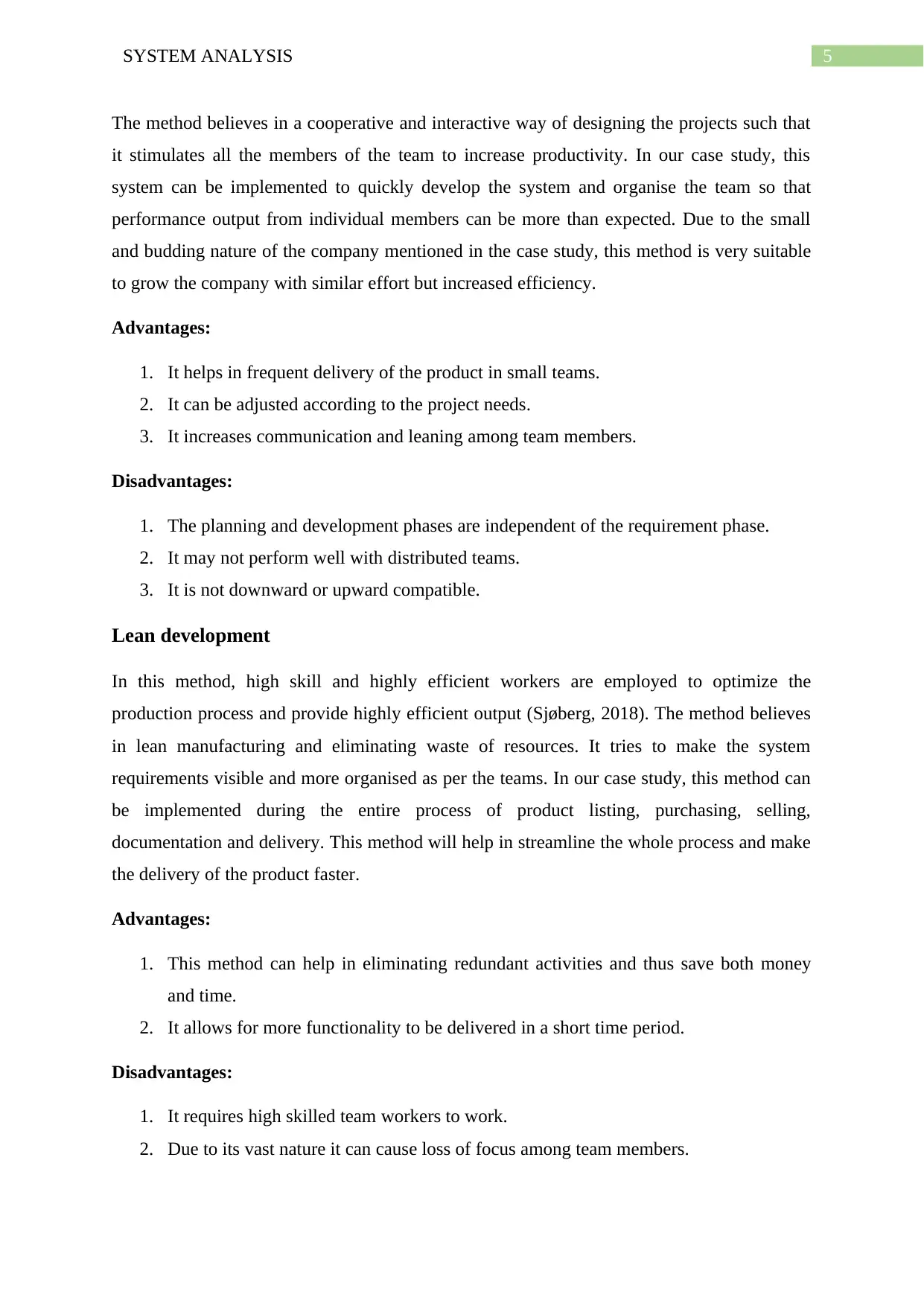
5SYSTEM ANALYSIS
The method believes in a cooperative and interactive way of designing the projects such that
it stimulates all the members of the team to increase productivity. In our case study, this
system can be implemented to quickly develop the system and organise the team so that
performance output from individual members can be more than expected. Due to the small
and budding nature of the company mentioned in the case study, this method is very suitable
to grow the company with similar effort but increased efficiency.
Advantages:
1. It helps in frequent delivery of the product in small teams.
2. It can be adjusted according to the project needs.
3. It increases communication and leaning among team members.
Disadvantages:
1. The planning and development phases are independent of the requirement phase.
2. It may not perform well with distributed teams.
3. It is not downward or upward compatible.
Lean development
In this method, high skill and highly efficient workers are employed to optimize the
production process and provide highly efficient output (Sjøberg, 2018). The method believes
in lean manufacturing and eliminating waste of resources. It tries to make the system
requirements visible and more organised as per the teams. In our case study, this method can
be implemented during the entire process of product listing, purchasing, selling,
documentation and delivery. This method will help in streamline the whole process and make
the delivery of the product faster.
Advantages:
1. This method can help in eliminating redundant activities and thus save both money
and time.
2. It allows for more functionality to be delivered in a short time period.
Disadvantages:
1. It requires high skilled team workers to work.
2. Due to its vast nature it can cause loss of focus among team members.
The method believes in a cooperative and interactive way of designing the projects such that
it stimulates all the members of the team to increase productivity. In our case study, this
system can be implemented to quickly develop the system and organise the team so that
performance output from individual members can be more than expected. Due to the small
and budding nature of the company mentioned in the case study, this method is very suitable
to grow the company with similar effort but increased efficiency.
Advantages:
1. It helps in frequent delivery of the product in small teams.
2. It can be adjusted according to the project needs.
3. It increases communication and leaning among team members.
Disadvantages:
1. The planning and development phases are independent of the requirement phase.
2. It may not perform well with distributed teams.
3. It is not downward or upward compatible.
Lean development
In this method, high skill and highly efficient workers are employed to optimize the
production process and provide highly efficient output (Sjøberg, 2018). The method believes
in lean manufacturing and eliminating waste of resources. It tries to make the system
requirements visible and more organised as per the teams. In our case study, this method can
be implemented during the entire process of product listing, purchasing, selling,
documentation and delivery. This method will help in streamline the whole process and make
the delivery of the product faster.
Advantages:
1. This method can help in eliminating redundant activities and thus save both money
and time.
2. It allows for more functionality to be delivered in a short time period.
Disadvantages:
1. It requires high skilled team workers to work.
2. Due to its vast nature it can cause loss of focus among team members.
⊘ This is a preview!⊘
Do you want full access?
Subscribe today to unlock all pages.

Trusted by 1+ million students worldwide
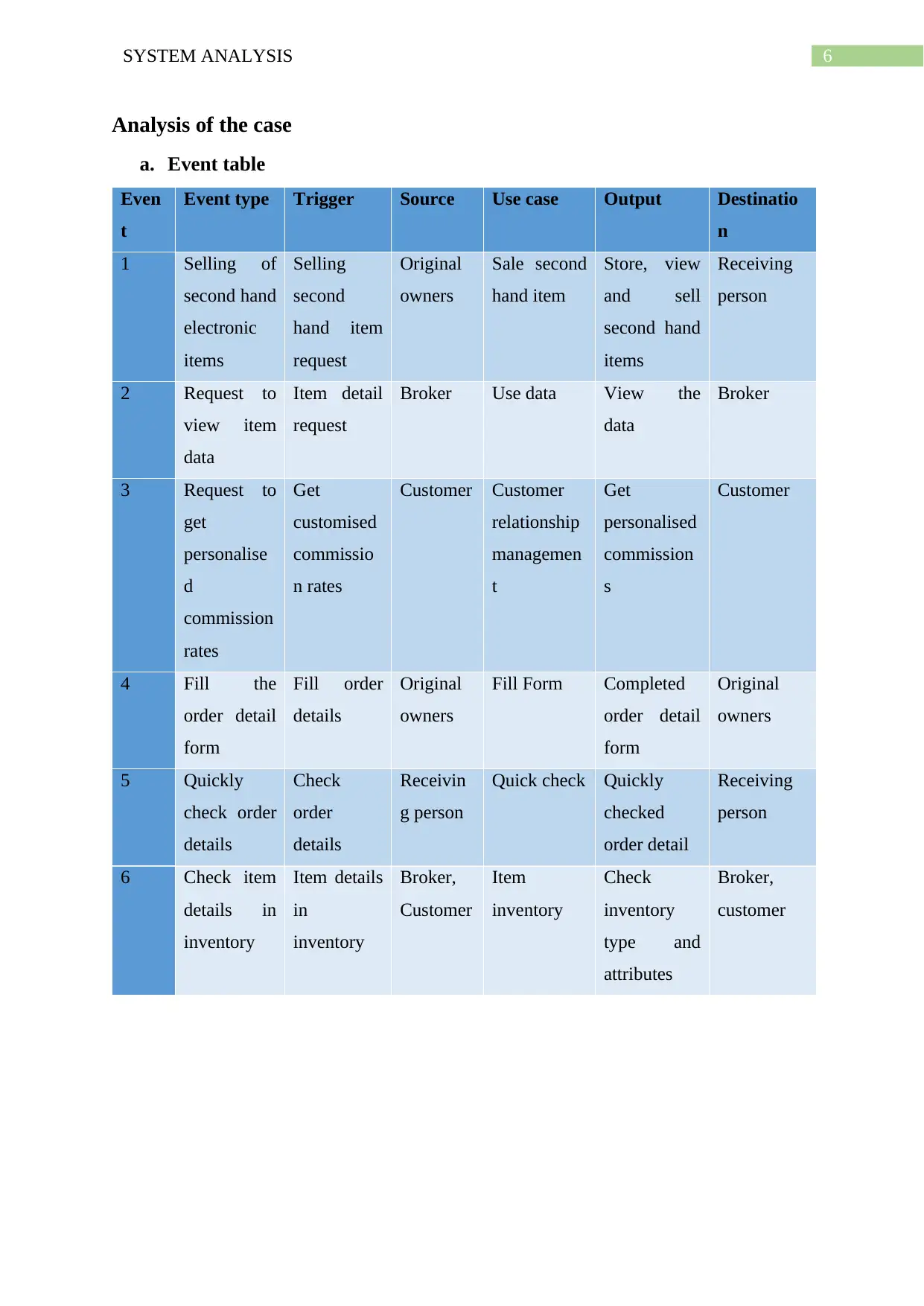
6SYSTEM ANALYSIS
Analysis of the case
a. Event table
Even
t
Event type Trigger Source Use case Output Destinatio
n
1 Selling of
second hand
electronic
items
Selling
second
hand item
request
Original
owners
Sale second
hand item
Store, view
and sell
second hand
items
Receiving
person
2 Request to
view item
data
Item detail
request
Broker Use data View the
data
Broker
3 Request to
get
personalise
d
commission
rates
Get
customised
commissio
n rates
Customer Customer
relationship
managemen
t
Get
personalised
commission
s
Customer
4 Fill the
order detail
form
Fill order
details
Original
owners
Fill Form Completed
order detail
form
Original
owners
5 Quickly
check order
details
Check
order
details
Receivin
g person
Quick check Quickly
checked
order detail
Receiving
person
6 Check item
details in
inventory
Item details
in
inventory
Broker,
Customer
Item
inventory
Check
inventory
type and
attributes
Broker,
customer
Analysis of the case
a. Event table
Even
t
Event type Trigger Source Use case Output Destinatio
n
1 Selling of
second hand
electronic
items
Selling
second
hand item
request
Original
owners
Sale second
hand item
Store, view
and sell
second hand
items
Receiving
person
2 Request to
view item
data
Item detail
request
Broker Use data View the
data
Broker
3 Request to
get
personalise
d
commission
rates
Get
customised
commissio
n rates
Customer Customer
relationship
managemen
t
Get
personalised
commission
s
Customer
4 Fill the
order detail
form
Fill order
details
Original
owners
Fill Form Completed
order detail
form
Original
owners
5 Quickly
check order
details
Check
order
details
Receivin
g person
Quick check Quickly
checked
order detail
Receiving
person
6 Check item
details in
inventory
Item details
in
inventory
Broker,
Customer
Item
inventory
Check
inventory
type and
attributes
Broker,
customer
Paraphrase This Document
Need a fresh take? Get an instant paraphrase of this document with our AI Paraphraser
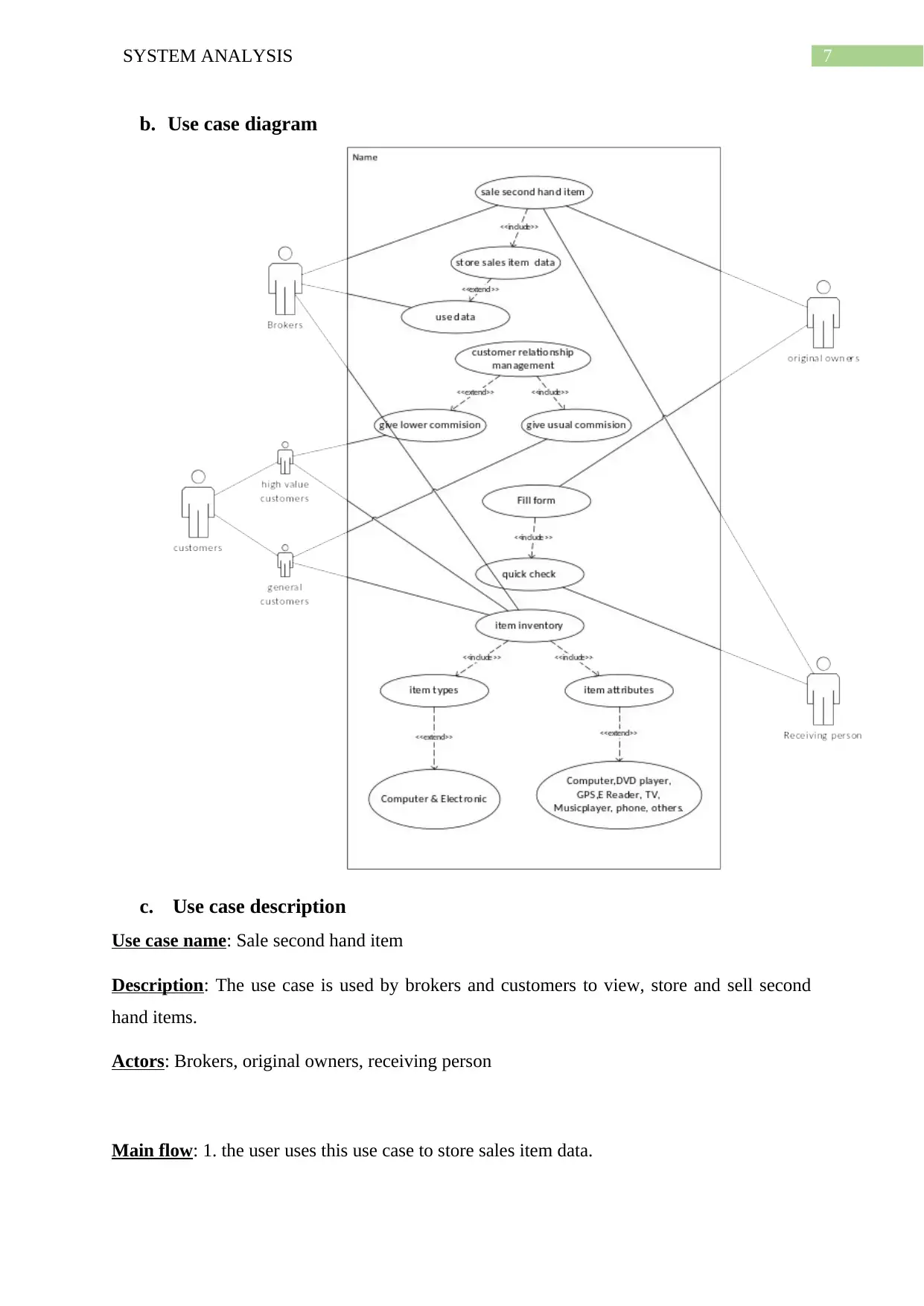
7SYSTEM ANALYSIS
b. Use case diagram
c. Use case description
Use case name: Sale second hand item
Description: The use case is used by brokers and customers to view, store and sell second
hand items.
Actors: Brokers, original owners, receiving person
Main flow: 1. the user uses this use case to store sales item data.
b. Use case diagram
c. Use case description
Use case name: Sale second hand item
Description: The use case is used by brokers and customers to view, store and sell second
hand items.
Actors: Brokers, original owners, receiving person
Main flow: 1. the user uses this use case to store sales item data.
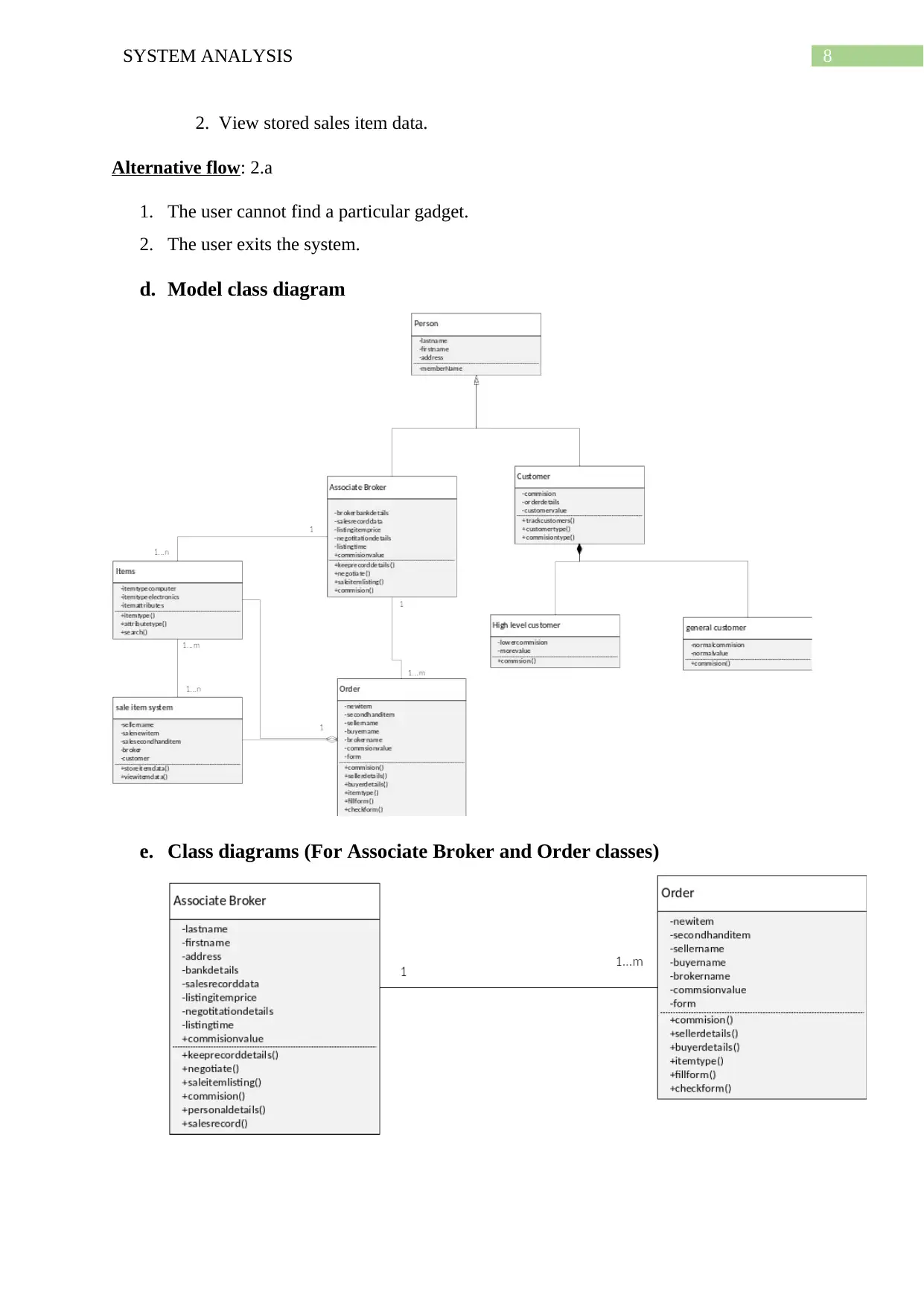
8SYSTEM ANALYSIS
2. View stored sales item data.
Alternative flow: 2.a
1. The user cannot find a particular gadget.
2. The user exits the system.
d. Model class diagram
e. Class diagrams (For Associate Broker and Order classes)
2. View stored sales item data.
Alternative flow: 2.a
1. The user cannot find a particular gadget.
2. The user exits the system.
d. Model class diagram
e. Class diagrams (For Associate Broker and Order classes)
⊘ This is a preview!⊘
Do you want full access?
Subscribe today to unlock all pages.

Trusted by 1+ million students worldwide
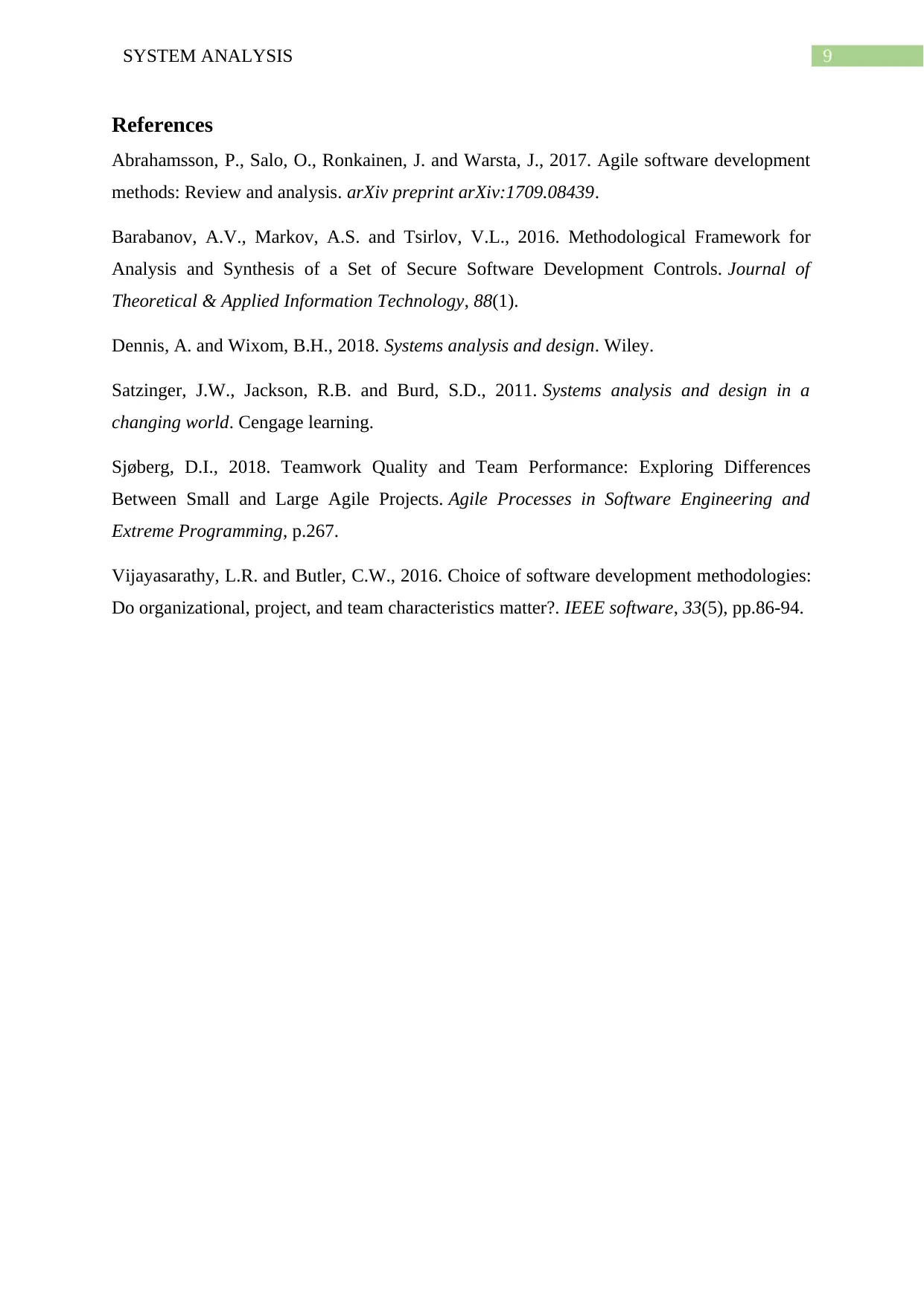
9SYSTEM ANALYSIS
References
Abrahamsson, P., Salo, O., Ronkainen, J. and Warsta, J., 2017. Agile software development
methods: Review and analysis. arXiv preprint arXiv:1709.08439.
Barabanov, A.V., Markov, A.S. and Tsirlov, V.L., 2016. Methodological Framework for
Analysis and Synthesis of a Set of Secure Software Development Controls. Journal of
Theoretical & Applied Information Technology, 88(1).
Dennis, A. and Wixom, B.H., 2018. Systems analysis and design. Wiley.
Satzinger, J.W., Jackson, R.B. and Burd, S.D., 2011. Systems analysis and design in a
changing world. Cengage learning.
Sjøberg, D.I., 2018. Teamwork Quality and Team Performance: Exploring Differences
Between Small and Large Agile Projects. Agile Processes in Software Engineering and
Extreme Programming, p.267.
Vijayasarathy, L.R. and Butler, C.W., 2016. Choice of software development methodologies:
Do organizational, project, and team characteristics matter?. IEEE software, 33(5), pp.86-94.
References
Abrahamsson, P., Salo, O., Ronkainen, J. and Warsta, J., 2017. Agile software development
methods: Review and analysis. arXiv preprint arXiv:1709.08439.
Barabanov, A.V., Markov, A.S. and Tsirlov, V.L., 2016. Methodological Framework for
Analysis and Synthesis of a Set of Secure Software Development Controls. Journal of
Theoretical & Applied Information Technology, 88(1).
Dennis, A. and Wixom, B.H., 2018. Systems analysis and design. Wiley.
Satzinger, J.W., Jackson, R.B. and Burd, S.D., 2011. Systems analysis and design in a
changing world. Cengage learning.
Sjøberg, D.I., 2018. Teamwork Quality and Team Performance: Exploring Differences
Between Small and Large Agile Projects. Agile Processes in Software Engineering and
Extreme Programming, p.267.
Vijayasarathy, L.R. and Butler, C.W., 2016. Choice of software development methodologies:
Do organizational, project, and team characteristics matter?. IEEE software, 33(5), pp.86-94.
Paraphrase This Document
Need a fresh take? Get an instant paraphrase of this document with our AI Paraphraser
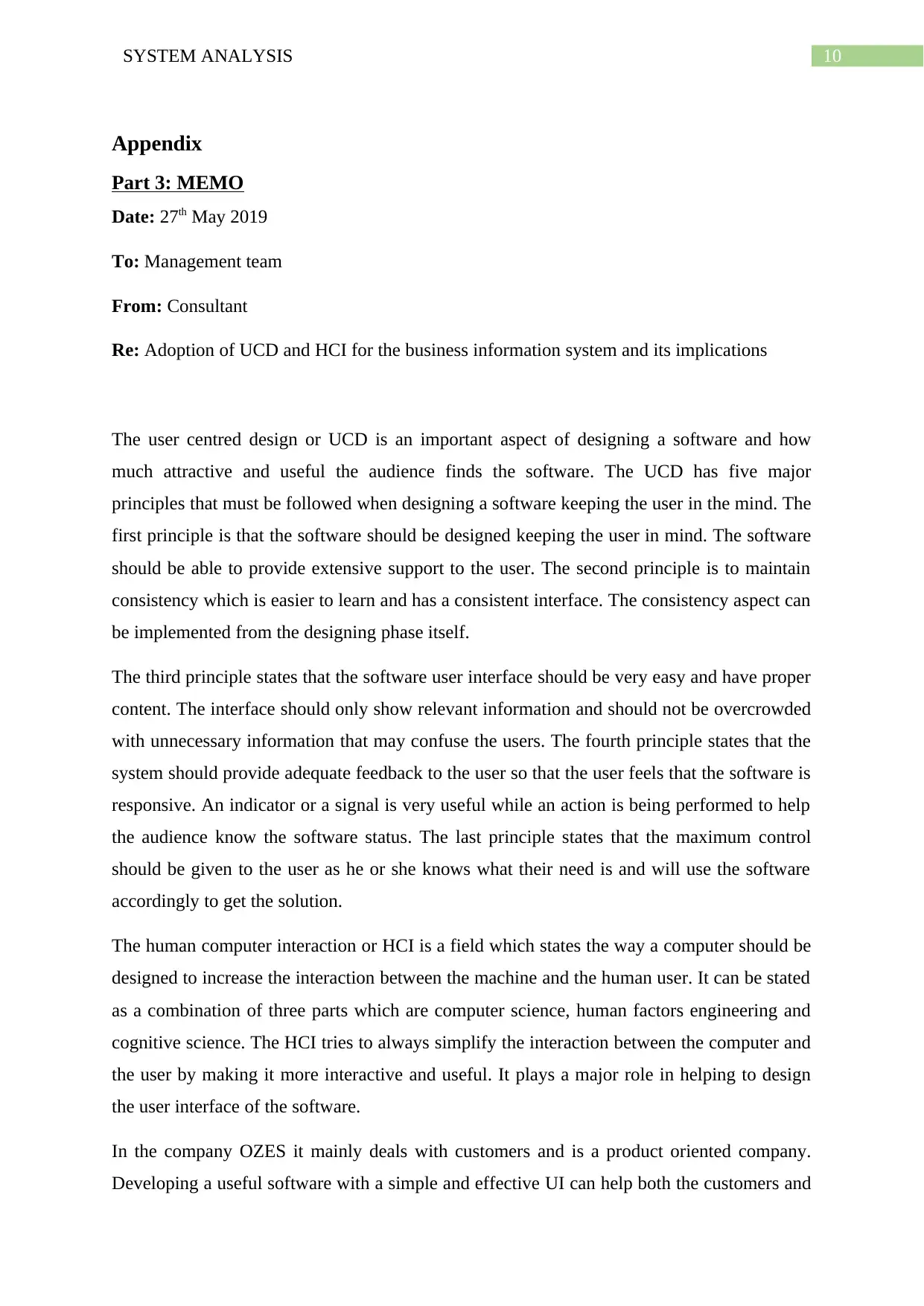
10SYSTEM ANALYSIS
Appendix
Part 3: MEMO
Date: 27th May 2019
To: Management team
From: Consultant
Re: Adoption of UCD and HCI for the business information system and its implications
The user centred design or UCD is an important aspect of designing a software and how
much attractive and useful the audience finds the software. The UCD has five major
principles that must be followed when designing a software keeping the user in the mind. The
first principle is that the software should be designed keeping the user in mind. The software
should be able to provide extensive support to the user. The second principle is to maintain
consistency which is easier to learn and has a consistent interface. The consistency aspect can
be implemented from the designing phase itself.
The third principle states that the software user interface should be very easy and have proper
content. The interface should only show relevant information and should not be overcrowded
with unnecessary information that may confuse the users. The fourth principle states that the
system should provide adequate feedback to the user so that the user feels that the software is
responsive. An indicator or a signal is very useful while an action is being performed to help
the audience know the software status. The last principle states that the maximum control
should be given to the user as he or she knows what their need is and will use the software
accordingly to get the solution.
The human computer interaction or HCI is a field which states the way a computer should be
designed to increase the interaction between the machine and the human user. It can be stated
as a combination of three parts which are computer science, human factors engineering and
cognitive science. The HCI tries to always simplify the interaction between the computer and
the user by making it more interactive and useful. It plays a major role in helping to design
the user interface of the software.
In the company OZES it mainly deals with customers and is a product oriented company.
Developing a useful software with a simple and effective UI can help both the customers and
Appendix
Part 3: MEMO
Date: 27th May 2019
To: Management team
From: Consultant
Re: Adoption of UCD and HCI for the business information system and its implications
The user centred design or UCD is an important aspect of designing a software and how
much attractive and useful the audience finds the software. The UCD has five major
principles that must be followed when designing a software keeping the user in the mind. The
first principle is that the software should be designed keeping the user in mind. The software
should be able to provide extensive support to the user. The second principle is to maintain
consistency which is easier to learn and has a consistent interface. The consistency aspect can
be implemented from the designing phase itself.
The third principle states that the software user interface should be very easy and have proper
content. The interface should only show relevant information and should not be overcrowded
with unnecessary information that may confuse the users. The fourth principle states that the
system should provide adequate feedback to the user so that the user feels that the software is
responsive. An indicator or a signal is very useful while an action is being performed to help
the audience know the software status. The last principle states that the maximum control
should be given to the user as he or she knows what their need is and will use the software
accordingly to get the solution.
The human computer interaction or HCI is a field which states the way a computer should be
designed to increase the interaction between the machine and the human user. It can be stated
as a combination of three parts which are computer science, human factors engineering and
cognitive science. The HCI tries to always simplify the interaction between the computer and
the user by making it more interactive and useful. It plays a major role in helping to design
the user interface of the software.
In the company OZES it mainly deals with customers and is a product oriented company.
Developing a useful software with a simple and effective UI can help both the customers and
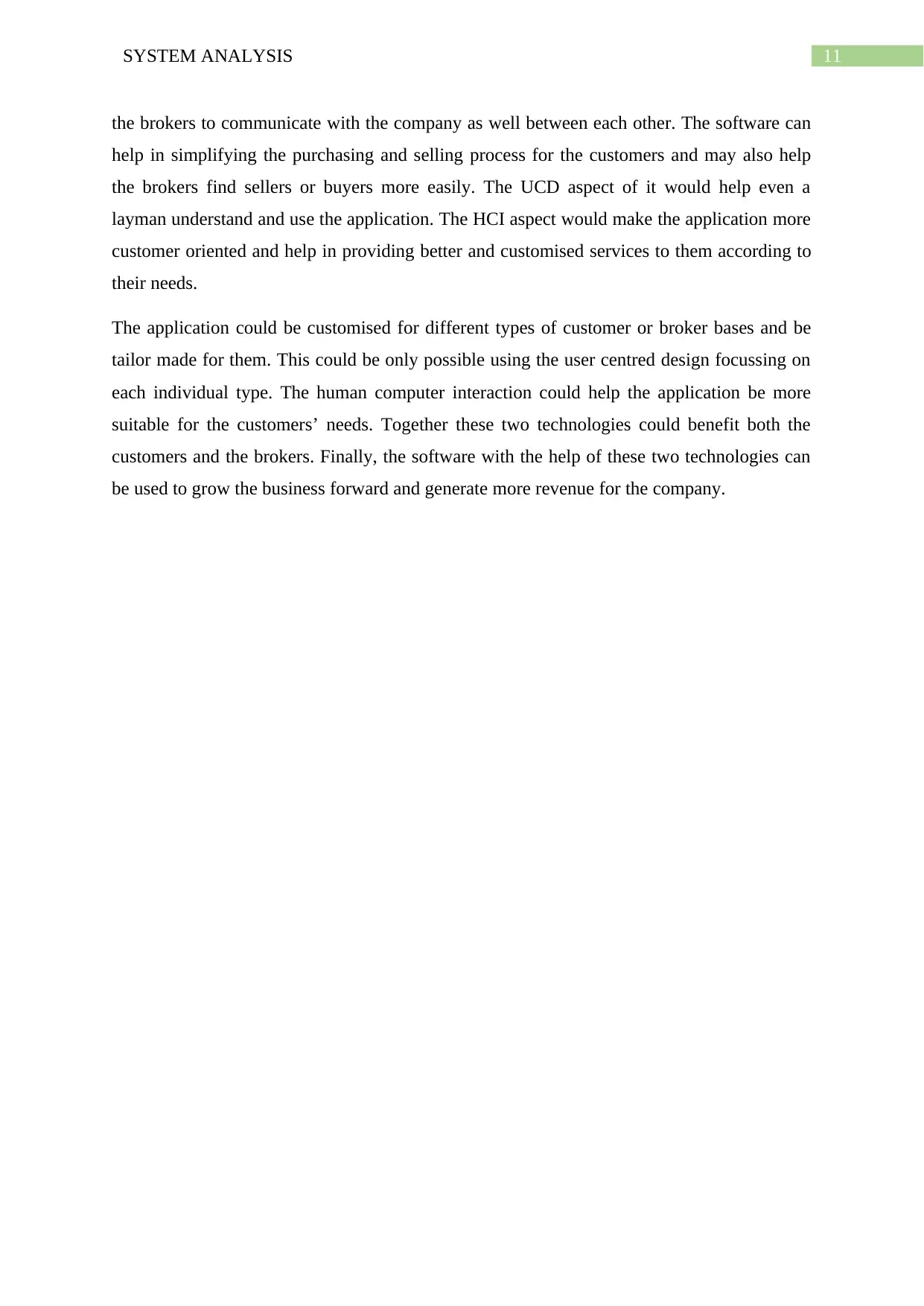
11SYSTEM ANALYSIS
the brokers to communicate with the company as well between each other. The software can
help in simplifying the purchasing and selling process for the customers and may also help
the brokers find sellers or buyers more easily. The UCD aspect of it would help even a
layman understand and use the application. The HCI aspect would make the application more
customer oriented and help in providing better and customised services to them according to
their needs.
The application could be customised for different types of customer or broker bases and be
tailor made for them. This could be only possible using the user centred design focussing on
each individual type. The human computer interaction could help the application be more
suitable for the customers’ needs. Together these two technologies could benefit both the
customers and the brokers. Finally, the software with the help of these two technologies can
be used to grow the business forward and generate more revenue for the company.
the brokers to communicate with the company as well between each other. The software can
help in simplifying the purchasing and selling process for the customers and may also help
the brokers find sellers or buyers more easily. The UCD aspect of it would help even a
layman understand and use the application. The HCI aspect would make the application more
customer oriented and help in providing better and customised services to them according to
their needs.
The application could be customised for different types of customer or broker bases and be
tailor made for them. This could be only possible using the user centred design focussing on
each individual type. The human computer interaction could help the application be more
suitable for the customers’ needs. Together these two technologies could benefit both the
customers and the brokers. Finally, the software with the help of these two technologies can
be used to grow the business forward and generate more revenue for the company.
⊘ This is a preview!⊘
Do you want full access?
Subscribe today to unlock all pages.

Trusted by 1+ million students worldwide
1 out of 12
Related Documents
Your All-in-One AI-Powered Toolkit for Academic Success.
+13062052269
info@desklib.com
Available 24*7 on WhatsApp / Email
![[object Object]](/_next/static/media/star-bottom.7253800d.svg)
Unlock your academic potential
Copyright © 2020–2025 A2Z Services. All Rights Reserved. Developed and managed by ZUCOL.





